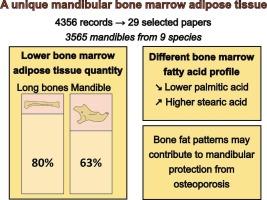The forgotten fat: A systematic review of mandibular adipose content
IF 3.6
2区 医学
Q2 ENDOCRINOLOGY & METABOLISM
引用次数: 0
Abstract
Bone marrow adipose tissue (BMAT) is increasingly recognized for its role in bone physiology and pathology, yet its characteristics in the mandible remain poorly understood compared to long bones and vertebrae. This systematic review aimed to summarize current knowledge on mandibular BMAT in healthy conditions.
A systematic review was conducted in PubMed, PMC-PubMed, and the Cochrane Library up to March 2025, supplemented by manual searches. Studies were included if they assessed the distribution, quantity, or composition of BMAT in physiological mandibular bone from mammals. Data were synthesized narratively according to PRISMA 2020 guidelines.
Out of 4356 records, 29 papers involving 3565 mandibles from 9 species were included. The weighted mean dried bone marrow fat fraction in healthy mandibles was 63 %, consistently lower than the 80 % weighted mean for healthy long bones in the included studies. Adipose volume per bone or marrow volume also suggested reduced fat content in the mandible. Fatty acid profiles indicated possible mandibular differences, with lower proportions of palmitic acid (16:0, 22–27 %) and higher stearic acid (18:0, 16 %) compared to long bones. A small study on caribou showed similar patterns, although interspecies variability was also evident.
Mandibular BMAT is quantitatively lower and compositionally distinct from that of long bones, which may contribute to site-specific responses in bone metabolism. However, heterogeneity in methodologies and lack of data on mineralized tissue lipids underscore the need for standardized protocols and further investigation.

被遗忘的脂肪:下颌脂肪含量的系统综述。
骨髓脂肪组织(BMAT)在骨骼生理和病理中的作用越来越被人们所认识,但与长骨和椎骨相比,它在下颌骨中的特征仍然知之甚少。本系统综述旨在总结健康条件下下颌BMAT的最新知识。在PubMed, PMC-PubMed和Cochrane图书馆进行了系统综述,直到2025年3月,并辅以人工检索。如果研究评估了哺乳动物生理性下颌骨中BMAT的分布、数量或组成,则纳入研究。根据PRISMA 2020指南对数据进行叙述性合成。在4356篇文献中,纳入29篇文献,涉及9个物种的3565个下颌骨。健康下颌骨的加权平均干骨髓脂肪含量为63 %,始终低于纳入研究的健康长骨的加权平均值80 %(见补充材料,表S2)。每根骨头的脂肪体积或骨髓体积也表明下颌骨的脂肪含量减少。脂肪酸谱表明下颌骨可能存在差异,与长骨相比,棕榈酸的比例较低(16:0,22-27 %),硬脂酸的比例较高(18:0,16 %)。一项针对北美驯鹿的小型研究也显示了类似的模式,尽管物种间的差异也很明显。下颌BMAT在数量上较低,在组成上与长骨不同,这可能有助于骨代谢的部位特异性反应。然而,方法的异质性和缺乏矿化组织脂的数据强调了标准化方案和进一步研究的必要性。
本文章由计算机程序翻译,如有差异,请以英文原文为准。
求助全文
约1分钟内获得全文
求助全文
来源期刊

Bone
医学-内分泌学与代谢
CiteScore
8.90
自引率
4.90%
发文量
264
审稿时长
30 days
期刊介绍:
BONE is an interdisciplinary forum for the rapid publication of original articles and reviews on basic, translational, and clinical aspects of bone and mineral metabolism. The Journal also encourages submissions related to interactions of bone with other organ systems, including cartilage, endocrine, muscle, fat, neural, vascular, gastrointestinal, hematopoietic, and immune systems. Particular attention is placed on the application of experimental studies to clinical practice.
 求助内容:
求助内容: 应助结果提醒方式:
应助结果提醒方式:


